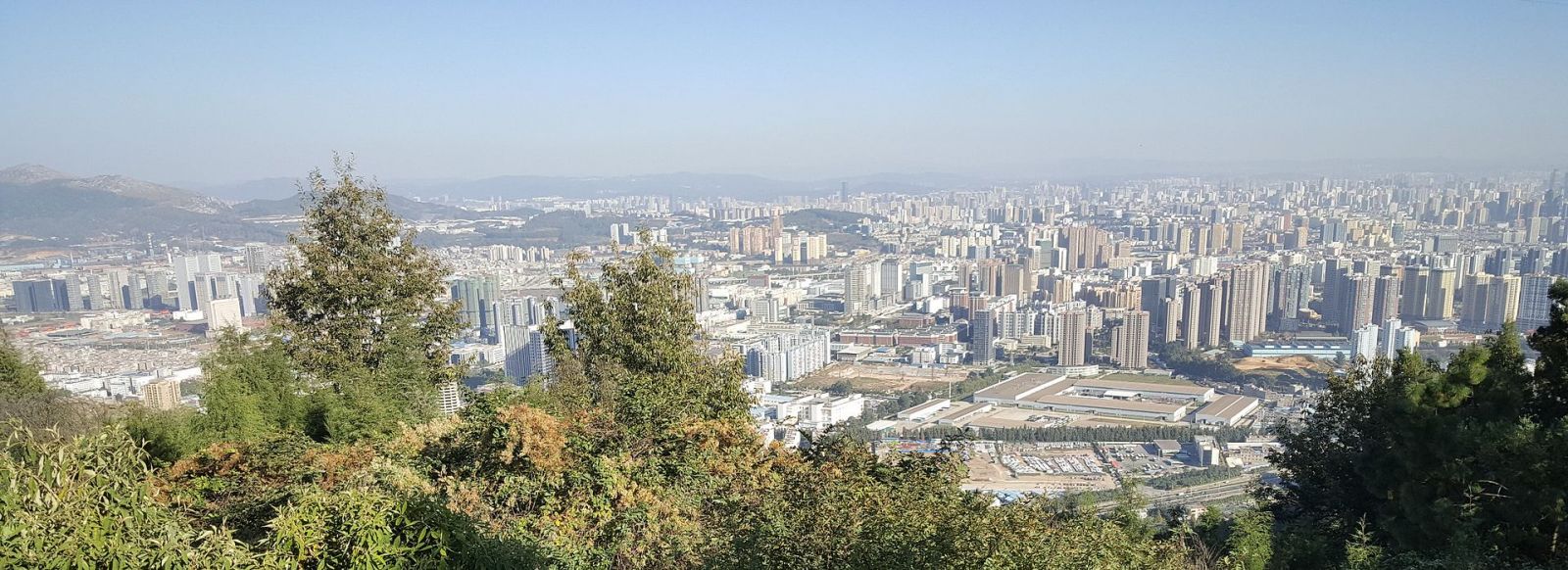Kunming
Kunming
Kunming, also known as Yunnan-Fu, is the capital and largest city of Yunnan province, China.
It is the political, economic, communications and cultural center of the province as well as the seat of the provincial government. 
The headquarters of many of Yunnan's large businesses are in Kunming. It was important during World War II as a Chinese military center, American air base, and transport terminus for the Burma Road.
In the middle of the Yunnan–Guizhou Plateau, Kunming is at an altitude of 1,900 meters (6,234 feet) above sea level and a latitude just north of the Tropic of Cancer. As of 2020 census, Kunming had a total population of 8,460,088.
As of the 2018 estimation, its urban population was 4,089,100, and its built-up (or metro) area made of all urban districts but Jinning, not conurbated yet, was home to 3,779,900 inhabitants.
It is at the northern edge of Dian Lake, surrounded by temples and lake-and-limestone hill landscapes.
Kunming consists of an old, previously walled city, a modern commercial district, residential zones and university areas. It is also one of the top 200 cities in the world by scientific research output as tracked by the Nature Index.
The city has an astronomical observatory, and its institutions of higher learning include Yunnan University, Kunming University of Science and Technology, Yunnan University of Finance and Economics, Kunming Medical University, Yunnan Normal University, Yunnan Agricultural University and Southwest Forestry University. On the northeast mountainous outskirt is a bronze temple dating from the Ming dynasty, the largest of its kind in China.
Kunming's economic importance derives from its geographical position. It is near the border with Southeastern Asian countries, serving as a transportation hub in Southwest China, linking by rail to Vietnam and by road to Burma, Laos and Thailand. This positioning also makes it an important trade center in the region.
It also houses some manufacturing, chiefly the processing of copper, as well as various chemicals, machinery, textiles, paper and cement.
Kunming has a nearly 2,400-year history, but its modern prosperity dates only to 1910, when the railway from Hanoi was built.
The city has continued to develop rapidly under China's modernization efforts. Kunming's streets have widened while office buildings and housing projects develop at a fast pace.
Kunming has been designated a special tourism center and as such sports a proliferation of high-rises and luxury hotels.
History
Early history
Kunming long profited from its position on the caravan roads through to South-East Asia, India and Tibet. Early townships in the southern edge of Lake Dian (outside the contemporary city perimeter) can be dated back to 279 BC, although they have been long lost to history. Early settlements in the area around Lake Dian date back to Neolithic times. The Dian Kingdom, whose original language was likely related to Tibeto-Burman languages was also established near the area.
Dian was subjugated by the Chinese Han dynasty under the reign of Emperor Wu of Han in 109 BC. The Han dynasty incorporated the territory of the Dian Kingdom into their Yizhou Commandery, but left the King of Dian as the local ruler.
The Han dynasty (205 BC–AD 220), seeking control over the Southern Silk Road running to Burma and India, brought small parts of Yunnan into China's orbit, though subsequent dynasties could do little to tame what was then a remote and wild borderland. During the Sui dynasty (581–618), two military expeditions were launched against the area, and it was renamed Kunzhou in Chinese sources.
Natural resources
Mineral resources include phosphorus, salt, magnesium, titanium, coal, quartz sand, clay, silica, copper. Phosphorus and salt mines are the most plentiful. Kunyang Phosphorus Mine is one of the three major phosphorus mines in the country. Rock salt reserves are 1.222 billion tonnes (1.203 billion long tons; 1.347 billion short tons) and mirabilite reserves are 1.908 billion tonnes (1.878 billion long tons; 2.103 billion short tons). Dongchuan is a major copper production base.
Proven reserves of Coal bed gas is about 500 billion cubic metres (18,000 billion cubic feet), equal to 720 million tonnes (710 million long tons; 790 million short tons) of standard coal.
Geothermal resources are widely distributed.
Environment and horticulture
Kunming has 2,585 hectares (6,390 acres) of lawns, trees and flowers, averaging 4.96 square metres (53.4 square feet) per capita and a green space rate of 21.7 percent. The city's smoke control area is 115 square kilometres (44 square miles) and noise control area 87 square kilometres (34 square miles).[citation needed]
Kunming is a significant horticultural center in China, providing products such as grain, wheat, horsebeans, corn, potato and fruit such as peaches, apples, oranges, grapes and chestnuts. Kunming is world-famous for its flowers and flower-growing exports. More than 400 types of flowers are commonly grown in Kunming. The camellia, Yulan magnolia, azalea, fairy primrose, lily and orchid are known as the six famous flowers of the city.
The camellia was confirmed by the Municipality of Kunming as its city flower in 1983.
The Kunming city government plans to create an environmental trial court to deal with environment-related lawsuits. It is to be part of the city's intermediate people's court and will have jurisdiction over appeals by companies that have been found guilty of violating environmental laws in cities throughout Yunnan.[39]


